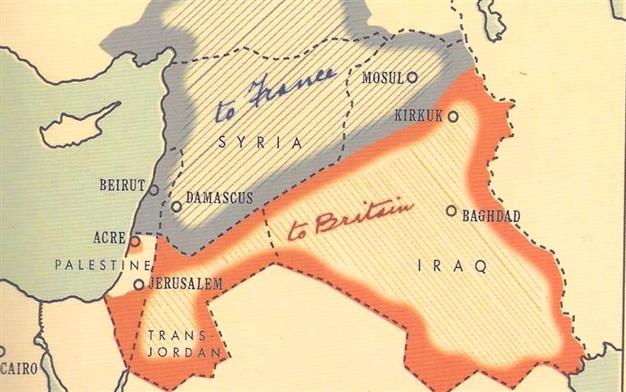Australia/Israel Review
Scribblings: Disagreement over an old agreement
Jun 1, 2016 | Tzvi Fleischer

Tzvi Fleischer
Much ink is being spilled at the moment to mark the 100th anniversary of the Sykes-Picot agreement – the British-French deal, reached in the midst of the First World War, to, at war’s end, divide up the Middle East possessions of the fading Ottoman Empire.
The intense interest in the agreement is perhaps understandable because of the current unstable situation in the Middle East – with central and important states like Iraq and Syria essentially ceasing to exist as political entities.
The typical line one often hears about Sykes-Picot can be summarised as something like this: Sykes-Picot was Western colonial powers creating artificial borders to serve their own interests which did not take into account local conditions and realities. The Middle East has been suffering ever since as a result of the artificial states and borders created – and the current implosion of the region’s major states is the culmination of the problems created by Sykes-Picot.
This narrative is at best a major oversimplification – even though there is room for serious scholarly debate about how over-simplified it is.
Anyone who doubts that this picture is a gross oversimplification should have a look at a map of the actual boundaries that the Sykes-Picot agreement proposed. You will find that virtually none of them correspond to the Middle East state boundaries that exist today. At most, you could say that Sykes-Picot began the process of dividing the central Levant into a northwestern state which became Syria and a southeastern one which became Iraq.
In fact, I personally lean to the view represented by Steven Cook of the US Council on Foreign Relations (http://tiny.cc/SPCook) and Adam Garfinkle, editor of The American Interest (http://tiny.cc/SPGarfinkle) who both argue essentially that the Sykes-Picot agreement has almost nothing to do with the later development of the states of the region.
Nonetheless, there are other knowledgeable scholars who do see Sykes-Picot as of some importance – even if not as important as the simplistic myth version makes it out to be.
However, there is a corollary of the myth version that has absolutely no basis in reality. This is the claim that Sykes-Picot was the beginning of the process of allowing Zionism to establish a Jewish state in Palestine. For instance, ANU Professor Amin Saikal, in a recent piece in the Canberra Times (May 21), referred to the “Sykes-Picot agreement of 1916” as one of the five causes of the current instability in the Levant. Under this point, he asserts “Britain forged an underhand deal with the World Zionist Congress to create a Jewish homeland in Palestine under British tutelage as a buffer against possible French ambitions.”
While Saikal’s precise intended meaning is unclear, the piece as written implied that the development of Zionism was linked to Sykes-Picot.
Yet as both top Israeli scholar Dr. Martin Kramer (The American Interest, May 19) and noted British scholar Dr. Colin Shindler (Jewish Chronicle, May 19) have recently noted, Sykes-Picot was strongly opposed by the Zionist movement, who rightly saw it as totally inimical to their goals. Britian’s leading Zionist of the time Chaim Weizmann, as quoted by Kramer, wrote of Sykes-Picot that it was “fatal to us” and created “the greatest single obstacle to our progress.” Similarly, according to Shindler, Harry Sacher, another leading British Zionist, wrote about Sykes-Picot: “We have been lied to and deceived all along and I shall never forgive the gentry… who have done this.”
And no wonder the Zionists were upset. The Sykes-Picot agreement proposed to divide the area of “Palestine” into not less than 5 pieces – with some northern areas under direct French control, others under the control of an Arab state aligned with France, still other parts under direct British control, some southern parts belonging to another British-aligned Arab state, and finally, much of the centre controlled by an ill-defined “international administration” which was apparently to be an Anglo-French condominium, with additional input from Russia, Italy and Arab leaders. Not only did this agreement offer the Zionists nothing, it actually divided up the existing Jewish towns and settlements in the area into different areas of control.
According to Kramer, Weizmann protested that were Sykes-Picot implemented, “the Jewish colonising effort of some thirty years [would be] annihilated.”
In fact, Zionist lobbying against it, together with British second thoughts about handing France control over an area so close to the Suez Canal, meant that Sykes-Picot was largely a dead letter by 1919. And Palestine became an exclusively British mandate. Kramer concludes that “Israel probably would never have been born, if the Sykes-Picot map had been implemented.”
So contrary to the myth, it was actually the failure of Sykes-Picot that made Zionism possible.
Even Hamas leaders want Israeli medical care
One of the high points in the story of Israel is the Israeli medical system – a place where Jewish and Arab doctors and nurses mingle freely to treat Jewish and Arab patients, who also mingle freely, and where medical outcomes compare favourably to virtually any country in the world.
Moreover, it seems worth noting that even some of Israel’s worst enemies are acknowledging how good it is by voting with their feet when medical necessity strikes.
Thus, in mid-April, PA President Mahmoud Abbas’ younger brother, Abu Louai, checked into Assuta Medical Centre, a private hospital in northern Tel Aviv, for treatment for his cancer. And he was not fleeing the Palestinian health services either – he lives in Qatar. Meanwhile, last October, Abbas’ brother-in-law underwent life-saving heart surgery, also at Assuta, and earlier last year, Amina Abbas, the Palestinian leader’s wife, was also hospitalised at Assuta.
Nor is Israeli treatment limited to PA-related Palestinian VIPs. In 2014, Israel’s hospitals also treated the sister of Hamas senior official Moussa Abu Marzouk for cancer, as well as Hamas leader Ismail Haniyeh’s mother-in-law, daughter and granddaughter at various times.
Tags: Israel






